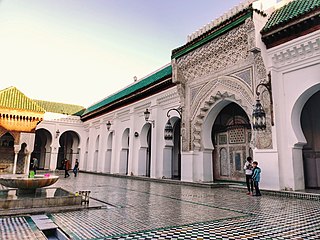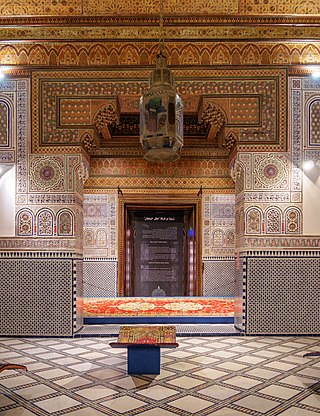
Haj Muhammad Ben Abdessalam al-Muqri was a senior Moroccan official of the late 19th and early 20th century. He was an adviser and grand vizier to several sultans of Morocco, including under French colonial domination.

A riad or riyad is a type of traditional Moroccan and Andalusi interior garden or courtyard associated with house and palace architecture. Its origin is generally attributed to Persian gardens that spread during the Islamic period. The term is nowadays often used in Morocco to refer to a hotel or guesthouse-style accommodation with shared common areas and private rooms, often within a restored traditional mansion.

The Bahia Palace is a mid to late 19th-century palace in Marrakesh, Morocco. The palace was first begun by Si Musa, grand vizier of Alaouite sultan Muhammad ibn Abd al-Rahman, in 1859 and then continued and expanded by his son Si Ba Ahmed ibn Musa, grand vizier of Sultan Moulay Abdelaziz between 1894 and 1900. Today it is a well-known historic monument and tourist attraction in the city.

The Museum of Marrakech is a historic palace and museum located in the old center of Marrakesh, Morocco. In addition to its notable architecture, the museum's collection showcases various historic art objects and contemporary art from Morocco.

Fes el Bali is the oldest walled part of Fez, Morocco. Fes el Bali was founded as the capital of the Idrisid dynasty between 789 and 808 AD. UNESCO listed Fes el Bali, along with Fes Jdid, as a World Heritage Site in 1981 under the name Medina of Fez. The World Heritage Site includes Fes el Bali's urban fabric and walls as well as a buffer zone outside of the walls that is intended to preserve the visual integrity of the location. Fes el Bali is, along with Fes Jdid and the French-created Ville Nouvelle or “New Town”, one of the three main districts in Fez.

Fez or Fes is a city in northern inland Morocco and the capital of the Fès-Meknès administrative region. It is the second largest city in Morocco, with a population of 1.11 million according to the 2014 census. Located to the north west of the Atlas Mountains, it is surrounded by hills and the old city is centered around the Fez River flowing from west to east.

Dar Ben Ayed is an old palace of the medina of Tunis. It is located in the Ben Ayed Street in Bab Jedid, near Tourbet el Bey and Souk Es Sabbaghine.

Dar Aziza is a 16th-century Moorish palace located in the Casbah of Algiers in Algeria. Today, it houses the National Agency of Archaeology and Protection of Historic Sites and Monuments. Dar Aziza, arguably the most iconic surviving building of its era in Algiers, was part of a large governmental compound known as Janina Palace, which existed before the arrival of Turkish corsairs.

Dar Batḥa, or Qasr al-Batḥa, is a former royal palace in the city of Fez, Morocco. The palace was commissioned by the Alaouite Sultan Hassan I in the late 19th century and finished under his successor Abdelaziz. It was converted into a museum of historical arts and crafts in 1915 with a collection that now comprises over 6,500 objects. The palace is located near Bab Bou Jeloud at the western edge of Fes el-Bali, the old medina quarter of the city, and close to Fes el-Jdid, the new medina quarter. It is adjacent to the Dar el-Beida palace located to its southeast, which was originally part of the same complex.

The Royal Palace or Dar al-Makhzen is the palace of the King of Morocco in the city of Fez, Morocco. Its original foundation dates back to the foundation of Fes el-Jdid, the royal citadel of the Marinid dynasty, in 1276 CE. Most of the palace today dates from the 'Alawi era. The vast grounds are home to multiple private structures, patios, and gardens, but historically also included administrative offices and government tribunals. Today, the most publicly visible parts of the palace are its main entrances at the Old Mechouar and the highly ornate 20th-century gates at Place des Alaouites, near the Mellah.

The architecture of Fez, Morocco, reflects the wider trends of Moroccan architecture dating from the city's foundation in the late 8th century and up to modern times. The old city (medina) of Fes, consisting of Fes el-Bali and Fes el-Jdid, is notable for being an exceptionally well-preserved medieval North African city and is classified as a UNESCO World Heritage Site. A large number of historic monuments from different periods still exist in it today, including mosques, madrasas, synagogues, hammams (bathhouses), souqs (markets), funduqs (caravanserais), defensive walls, city gates, historic houses, and palaces.

Dar el Bacha is a palace located in the old medina of Marrakesh, Morocco. It currently houses the Museum of Confluences.

Dar Si Said is a historic late 19th-century palace and present-day museum in Marrakesh, Morocco.

Dar Adiyel or Dar 'Adiyil is a historic mansion in Fes el-Bali, the old medina of Fes, Morocco. It is located in the Zqaq el-Bghal neighbourhood, a short distance south from Tala'a Seghira street.

The Dar Jamai Museum is a museum in Meknes, Morocco. It displays a number of artifacts and art objects from the city and other regions in Morocco. It is housed in a late 19th-century palace built by the Jama'i family who also built the Jamai Palace in Fes.

Dar Ba Mohammed Chergui, also known as Dar al-Aman, is a historic palace or riad-style mansion in the old medina of Fez, Morocco. It is located on Derb el Horra street in Fes el-Bali.

Dar Glaoui or Glaoui Palace is a late 19th-century and early 20th-century palace in Fez, Morocco. It was owned by the Glaoui family, whose most famous members were the Grand Vizier Madani and his brother Thami, pasha of Marrakech. The palace is located in the southwestern district of Fes el-Bali, in an area containing other historic mansions.

The Dar el-Beida is a royal residence in Fez, Morocco. It was originally part of the same complex as the adjacent Dar Batha to its northeast, but was separated in 1915 as the latter was repurposed as a museum. It remains an official residence today, inaccessible to the public.

Traditional houses in Morocco are usually centered around a large internal courtyard, the wast ad-dar, and are characterized by a focus on interior decoration rather than on external appearance. The houses of wealthy residents featured decoration typical of Moroccan architecture and medieval Moorish architecture, including carved and painted wood, carved stucco, and zellij. The center of larger houses could also be occupied by a riad, particularly in places like Marrakesh where more space was available.























